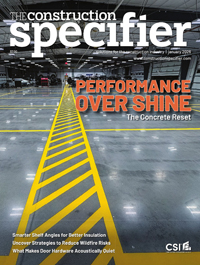The growing demand for transparency in buildings

LEED v4
In LEED v4, the two main credits focus on product transparency—Building Product Disclosure and Optimization (BPDO) – Environmental Product Declarations (EPDs) and BPDO – Material Ingredients. Although multiple choices are available for these credits, this section focuses only on the first option for both, since, according to Nadav Malin, president of independent consultancy BuildingGreen, the others are unachievable at this time for most project teams. There is also one additional BPDO credit within LEED—Sourcing of Raw Materials. More information on this credit can be found on the USGBC website.
LEED v4 BPDO – EPDs
Within BPDO – EPDs, the first option is to use at least 20 permanently installed products, sourced from at least five different manufacturers with environmental transparency documentation. Acceptable forms of documentation include life-cycle assessments (LCAs), industry-wide EPDs, and product-specific type III EPDs. However, each form can count as a different number of equivalent products, ranging from one-quarter of a product for LCAs to one whole product for product-specific type III EPDs. There is also an option to utilize PEPs, which are EPDs for the electric, electronic, and heating and cooling industries. When externally verified, PEPs count as one product, and when internally verified, counts as three-quarters of a product. In practice, this means that design professionals can select different forms of documentation from multiple types, as long as they total 20 equivalent products (i.e. two industry-wide EPDs would be needed to earn credit for one product).
LEED v4 BPDO – Material Ingredients
Turning to the LEED v4 BPDO – Material Ingredients credit, the first option is to use at least 20 permanently installed products, sourced from at least five different manufacturers, with their chemical inventory disclosed down to at least 0.1 percent (1000 ppm). Acceptable forms of documentation include a manufacturer inventory, HPD, C2C certification, C2C Material Health Certificate, Declare Label, the American National Standards Institute/Business and Institutional Furniture Manufacturers Association (ANSI/BIFMA) e3, Furniture Sustainability Standard, UL Product Lens Certification, and Facts – NSF/ANSI 336, Sustainability Assessment for Commercial Furnishings Fabric.
When v4 was first developed, the intention of including these credits was to incentivize the selection of products with transparency documentation. However, their acceptance by project teams has been low when compared to other credits. This is likely due to two factors, confusion regarding the types of forms available and the perception EPDs and material transparency documentation are hard to find. USGBC has addressed the first factor in LEED v4.1, which will be discussed next, and the second factor will be addressed later in the article.
LEED v4.1
According to USGBC, LEED v4.1—released as a beta version in early 2019—is “focused on the implementation, applicability, and agility of LEED,” and has the following goals:
- address market barriers and lessons learned from LEED v4 project teams;
- update performance thresholds and reference standards to ensure LEED remains the global leadership standard for green buildings;
- expand the marketplace for LEED; and
- improve performance throughout the life of buildings, reward leaders, and incorporate performance reporting to enable owners to track progress toward environmental, social, and governance goals.
Although this is only a ‘.1’ update, there are several significant changes throughout the rating system, including to BPDO credits.
LEED v4.1 BPDO – EPDs
Within the first option, USGBC simplified the requirements so all LCA and EPD options, with the exception of third-party verified EPDs, are worth one product. Third-party verified EPDs are now worth one-and-a-half products. Within the second option, which is focused on product improvement/optimization rather than just disclosure, they have made two major changes in an attempt to make the credit more achievable. The first was to lower the threshold from 50 percent of permanently installed products by cost to 10, with the option of using 10 permanently installed products from three different manufacturers. The second was to create two tiers of improvement options, with the first being the publishing of a life-cycle impact reduction action plan (valued at 50 percent by cost or one-half of a product), and the second being demonstrating life-cycle impact reductions in embodied carbon (the value ranges from 100 percent by cost or one product to 200 by cost or two products). Put another way, the new version of LEED will make it easier to reach the BPDO – EPDs Option 2 Credit by way of lowering the threshold for product selection criteria for materials with disclosure and optimization documentation, and incentivizing manufacturers to create impact reduction action plans and/or to demonstrate reductions in embodied carbon.
LEED v4.1 BPDO – Material Ingredients
Within the first option, the main change was to increase the value of third-party verified material transparency documents to one-and-a-half products. In the second option, which is focused on selecting products with documented material ingredient optimization, USGBC again lowered the threshold to either 10 percent of permanently installed products by cost, or 10 compliant products. Similar to the EPD credit, USGBC has implemented a tiered structure, allowing manufacturers to demonstrate continuous improvement ranging from the creation of an optimization action plan to the removal of substances of concern. The methods for achieving the second option beyond the action plan are detailed on the USGBC website. Overall, the key takeaway for the second option is the selection of products with fewer substances of concern may also make the project eligible to earn an additional LEED point.
WELL Building Standard v2
The WELL Building Standard, which is overseen by the International Well Building Institute (IWBI) and was launched in 2014, is the “standard for buildings, interior spaces, and communities seeking to implement, validate, and measure features supporting and advancing human health and wellness.”






